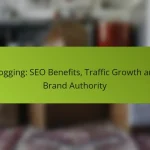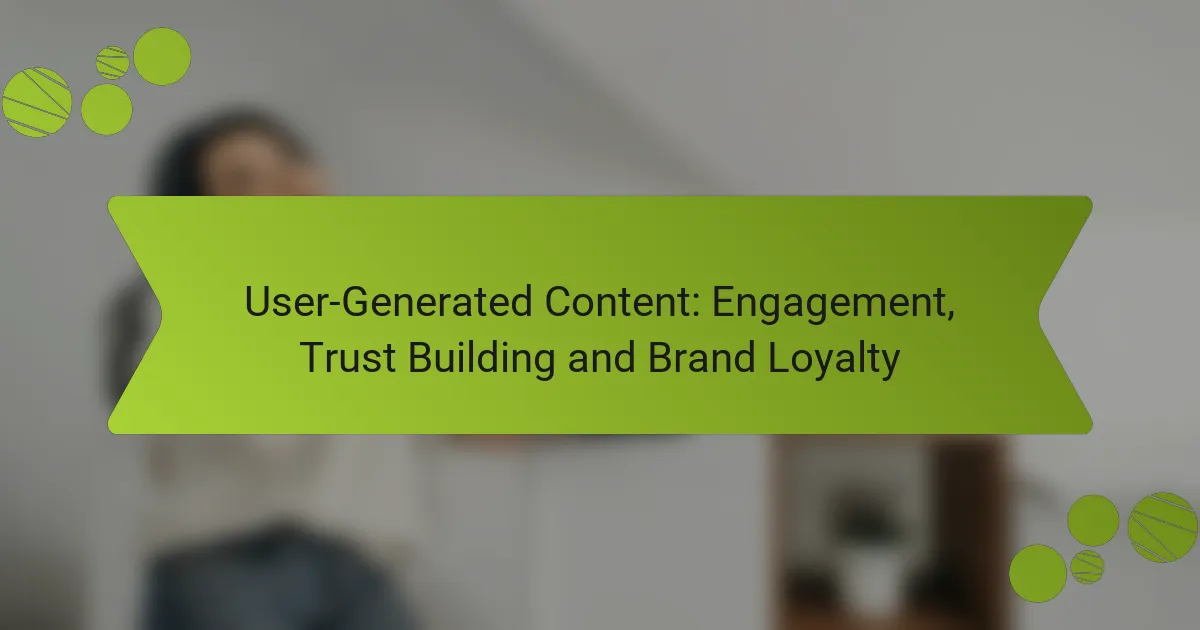Facebook Ads provide powerful targeting strategies that enable advertisers to connect with specific audiences, enhancing ad performance and maximizing return on investment. With a diverse range of ad formats available, including image, video, and carousel ads, marketers can effectively engage users based on their preferences. To achieve optimal results, it’s essential to set clear objectives, conduct A/B testing, and continuously monitor performance metrics throughout the campaign.
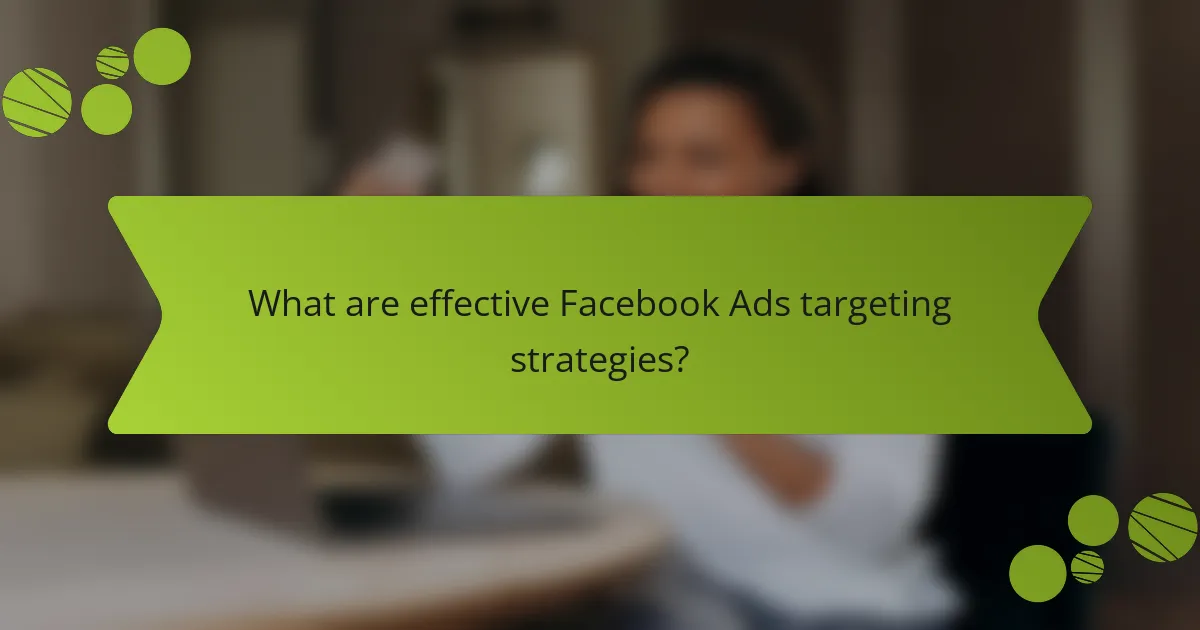
What are effective Facebook Ads targeting strategies?
Effective Facebook Ads targeting strategies focus on reaching the right audience to maximize ad performance and return on investment. By utilizing various targeting options, advertisers can tailor their campaigns to specific demographics, interests, and behaviors, ensuring their ads resonate with potential customers.
Demographic targeting
Demographic targeting allows advertisers to reach users based on specific characteristics such as age, gender, education level, and location. This strategy is essential for businesses that cater to particular demographic groups, enabling more relevant ad placements.
For example, a luxury brand may focus on users aged 30-50 with higher education levels, while a youth-oriented product might target individuals aged 18-24. Understanding your target demographic helps refine your audience and improve ad effectiveness.
Interest-based targeting
Interest-based targeting enables advertisers to connect with users based on their hobbies, interests, and activities. Facebook collects data on user interactions, allowing businesses to target audiences who have shown interest in related topics or products.
For instance, a fitness brand could target users interested in health, wellness, and sports. This approach increases the likelihood of engaging users who are more likely to respond positively to the ads.
Custom audiences
Custom audiences are created by uploading a list of contacts, such as email addresses or phone numbers, to Facebook. This strategy allows businesses to retarget existing customers or leads who have previously interacted with their brand.
Using custom audiences can enhance ad relevance and conversion rates, as these users are already familiar with the brand. It’s crucial to ensure compliance with data protection regulations when using customer data for targeting.
Lookalike audiences
Lookalike audiences help advertisers find new potential customers by targeting users similar to their existing customers. Facebook analyzes the characteristics of a custom audience and identifies users who share similar traits, expanding the reach of the campaign.
This strategy is particularly effective for scaling campaigns, as it allows businesses to tap into new markets with a higher likelihood of conversion. Advertisers should regularly update their custom audiences to maintain accuracy in lookalike targeting.
Behavioral targeting
Behavioral targeting focuses on users’ online behaviors, such as their purchase history, device usage, and engagement with other ads. This strategy allows advertisers to reach users based on their actions and preferences, enhancing the relevance of the ads shown.
For example, a travel agency might target users who have recently searched for flights or hotels. By understanding user behavior, businesses can create more personalized ad experiences that drive higher engagement and conversion rates.

What ad formats are available on Facebook?
Facebook offers a variety of ad formats to cater to different marketing objectives and audience preferences. These formats include image, video, carousel, collection, and slideshow ads, each designed to engage users in unique ways.
Image ads
Image ads are straightforward and visually appealing, making them a popular choice for brands. They typically feature a single image along with a caption and a call-to-action button, allowing for quick engagement.
When creating image ads, ensure the visuals are high-quality and relevant to your message. Use eye-catching images that resonate with your target audience to enhance click-through rates.
Video ads
Video ads allow brands to tell a story or showcase products in a dynamic way. These ads can be up to 240 minutes long, but shorter videos, around 15-30 seconds, often perform better due to user attention spans.
Consider using captions, as many users watch videos without sound. Engaging visuals and a clear message can significantly improve viewer retention and conversion rates.
Carousel ads
Carousel ads enable advertisers to showcase multiple images or videos within a single ad, allowing users to swipe through different visuals. This format is effective for displaying a range of products or telling a sequential story.
Each card in a carousel can link to different landing pages, making it a versatile option. Aim for a cohesive theme across the cards to maintain user interest and drive engagement.
Collection ads
Collection ads combine video or image elements with product listings, providing a seamless shopping experience. When users click on the ad, they are taken to a full-screen experience featuring additional products.
This format is particularly effective for e-commerce brands, as it allows for easy browsing and purchasing. Ensure that the featured products are visually appealing and relevant to the audience’s interests.
Slideshow ads
Slideshow ads use a series of images or video clips to create a looping video, which is a lightweight alternative to traditional video ads. They are ideal for brands with limited video resources but still want to create engaging content.
These ads can be created quickly and are less data-intensive, making them suitable for users with slower internet connections. Use compelling visuals and concise messaging to capture attention effectively.
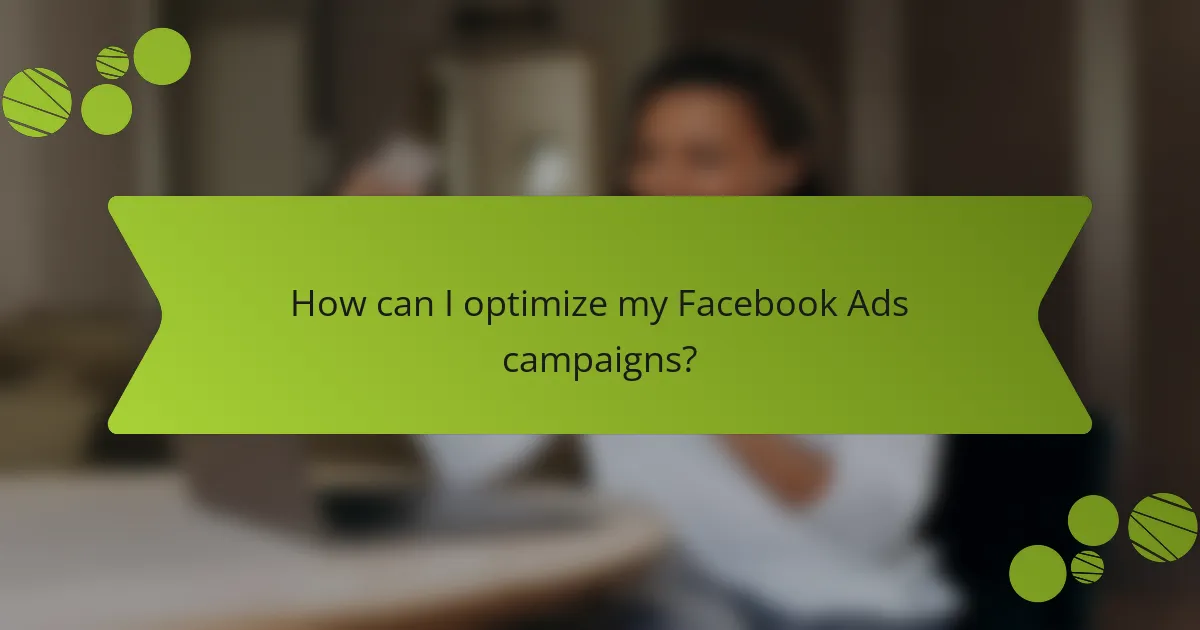
How can I optimize my Facebook Ads campaigns?
To optimize your Facebook Ads campaigns, focus on setting clear objectives, conducting A/B testing, and monitoring performance metrics. These strategies will help you refine your approach, improve engagement, and increase your return on investment.
Setting clear objectives
Establishing clear objectives is crucial for effective Facebook Ads campaigns. Define what you want to achieve, whether it’s increasing brand awareness, generating leads, or driving sales. Specific goals will guide your targeting, ad formats, and budget allocation.
Consider using the SMART criteria—Specific, Measurable, Achievable, Relevant, Time-bound—to ensure your objectives are well-defined. For example, instead of aiming to “increase sales,” set a goal to “boost online sales by 20% over the next quarter.”
A/B testing
A/B testing, or split testing, allows you to compare different ad variations to determine which performs better. Create two or more versions of an ad with slight differences, such as images, headlines, or calls to action, and run them simultaneously.
Monitor the results to see which version yields higher engagement or conversion rates. Aim for a testing period of at least a week to gather sufficient data, and use the insights to refine your future ads.
Monitoring performance metrics
Regularly monitoring performance metrics is essential to understand how your ads are performing. Key metrics to track include click-through rates (CTR), conversion rates, and cost per action (CPA). These indicators will help you assess the effectiveness of your campaigns.
Utilize Facebook Ads Manager to access detailed analytics. Set benchmarks based on industry standards to evaluate your performance and identify areas for improvement.
Adjusting targeting settings
Adjusting your targeting settings can significantly impact your campaign’s success. Use Facebook’s audience targeting options to reach specific demographics, interests, or behaviors that align with your objectives.
Regularly review and refine your audience settings based on performance data. For instance, if a particular demographic is responding well, consider increasing your budget for that segment while reducing spend on less effective groups.
Utilizing retargeting strategies
Retargeting strategies help you reconnect with users who have previously interacted with your brand. By displaying ads to these users, you can remind them of your products or services and encourage them to complete their purchase.
Implement Facebook Pixel on your website to track visitor behavior and create custom audiences for retargeting. This approach can lead to higher conversion rates, as these users are already familiar with your brand.

What are the prerequisites for successful Facebook Ads?
Successful Facebook Ads require a clear understanding of your target audience, well-defined campaign goals, and a strategic budget allocation. These elements are essential for creating effective ads that resonate with users and achieve desired outcomes.
Understanding target audience
Identifying your target audience is crucial for Facebook Ads success. This involves analyzing demographics, interests, and online behaviors to tailor your messaging effectively. Utilize Facebook’s Audience Insights tool to gather data on potential customers.
Consider creating detailed buyer personas that represent your ideal customers. This can help in crafting ads that speak directly to their needs and preferences, increasing engagement and conversion rates.
Defining campaign goals
Establishing clear campaign goals is vital for measuring success. Common objectives include increasing brand awareness, generating leads, or driving sales. Each goal requires a different approach and ad format, so clarity is key.
Use the SMART criteria (Specific, Measurable, Achievable, Relevant, Time-bound) to define your goals. For instance, aiming to increase website traffic by 20% within three months provides a clear target to work towards.
Budget allocation
Effective budget allocation ensures that your Facebook Ads reach the right audience without overspending. Start by determining your overall marketing budget and then allocate a portion specifically for Facebook Ads, considering factors like audience size and campaign duration.
Monitor your ad performance regularly to adjust spending as needed. A common practice is to allocate around 10-20% of your overall marketing budget to Facebook Ads, but this can vary based on your specific goals and market conditions.
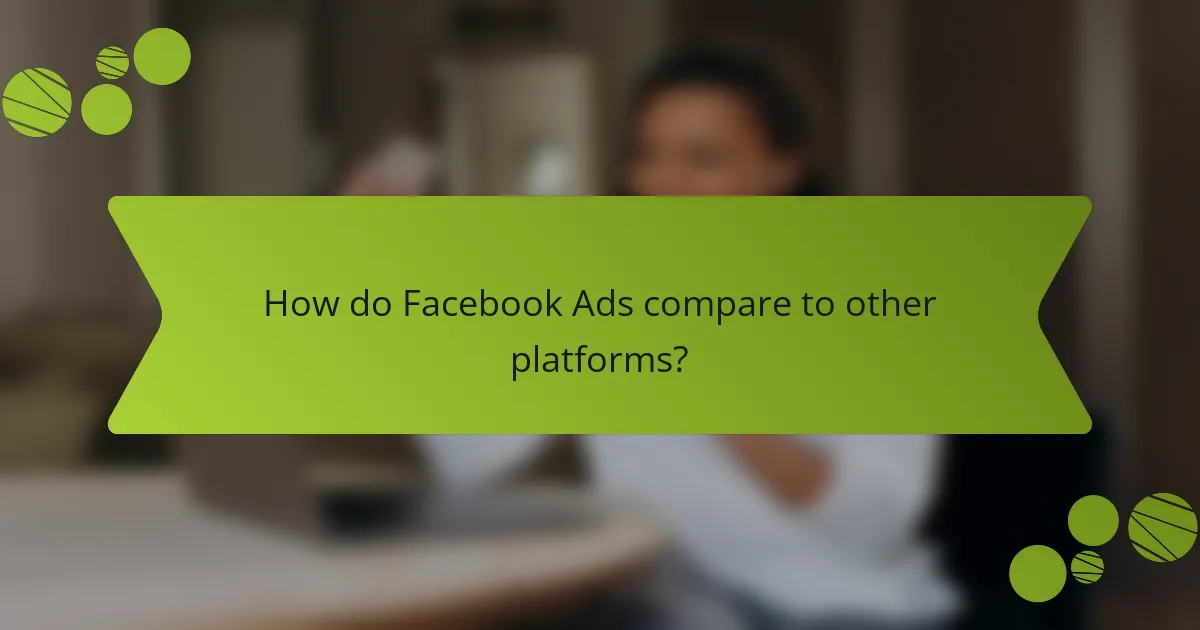
How do Facebook Ads compare to other platforms?
Facebook Ads offer unique advantages over other advertising platforms, particularly in terms of audience targeting and engagement. While platforms like Google Ads focus on intent-driven search, Facebook excels in demographic and interest-based targeting, allowing advertisers to reach specific user segments effectively.
Targeting Strategies
Facebook Ads provide robust targeting strategies that enable advertisers to reach their desired audience based on demographics, interests, behaviors, and location. Advertisers can create custom audiences from their existing customer lists or use lookalike audiences to find new potential customers who share similar traits.
For effective targeting, consider using Facebook’s Audience Insights tool to analyze your target demographics and refine your ad strategy. This tool can help identify key interests and behaviors that resonate with your audience, enhancing your ad’s relevance and performance.
Ad Formats
Facebook offers a variety of ad formats, including image ads, video ads, carousel ads, and slideshow ads. Each format serves different marketing objectives, such as brand awareness, lead generation, or product promotion. For instance, video ads are particularly effective for storytelling and engaging users, while carousel ads allow showcasing multiple products or features in a single ad.
When choosing an ad format, consider your campaign goals and the message you want to convey. Experimenting with different formats can help determine which resonates best with your audience, leading to improved engagement and conversion rates.
Campaign Optimization
Optimizing Facebook ad campaigns involves continuous monitoring and adjusting based on performance metrics. Key performance indicators (KPIs) such as click-through rates, conversion rates, and cost per acquisition should guide your optimization efforts. Regularly testing different ad creatives, targeting options, and bidding strategies can help identify the most effective combinations.
Utilize Facebook’s A/B testing feature to compare different ad variations and determine which performs better. This data-driven approach allows for informed decisions that can enhance overall campaign effectiveness and maximize return on investment (ROI).
